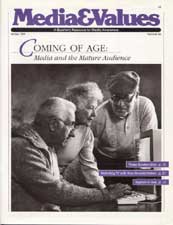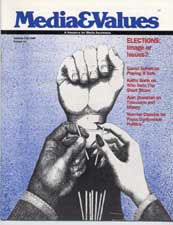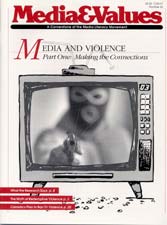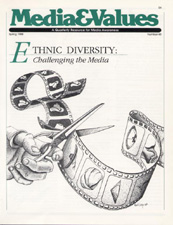Reading Room Search
Go here for complete Reading Room Article Index
Displaying 301 - 325 of 607
Older viewers face a confusing TV world. Despite recent improvements, over-50 characters are all too often stereotyped or ignored. Crime and violence featured on news and action shows contribute to older people's unease about their personal safety. At the same time, commercials and features imply that the magic of technology can eliminate the physical toll of aging itself. Stereotyping and media misunderstanding must be found on many levels. Making older viewers the stars of their own shows is one of the most effective, since it raises self-esteem while providing hands-on media instruction.... Read More

Once almost invisible, older characters are now prominent in many movies, TV shows and commercials. But as entertainment, marketing and communications experts reveal, the "graying of the media" often hides new, more subtle stereotypes and ambivalence about aging.
When we first discussed an issue on media and aging, Cocoon was delighting audiences of all ages in movie theatres and The Golden Girls had become the hit of Saturday night television.
All of a sudden it was OK to be gray. We wondered how much mass media was intertwined with this trend? And what future impact media would have as... Read More

Today's children are more likely to have living grandparents and perhaps great-grandparents than youngsters a century ago. But distance, estrangement, death, even work (yes, the elderly work, too) separate many children from their grandparents. Media can provide a link. Current programming portraying aging adults is beginning to show them as three-dimensional individuals with ideas, interests, emotions and energy. Shows like Our House, The Golden Girls, and even Captain Kangaroo provide a variety of models for children to consider. Children whose contact with older relatives is limited,... Read More
How does Hollywood Handle Ageism?
A conversation with two industry veterans: Dorothea and Dan Petrie
Editor's Note: Is there ageism in Hollywood? According to a recent report by the Writers Guild of America on employment trends in the mid-1980s, the preference for youthful writers, directors and producers may be increasing even as movies and television feature more older people as primary characters.
In the following interview, Media&Values talks with Dorothea and Daniel Petrie, a Hollywood couple who are both well-known for their production savvy and topflight direction and production credits. Dorothea Petrie produced, among other projects, Foxfire, Love Is Never Silent and Picking... Read More

Distress over the state of political reporting has now become a regular feature of every presidential campaign season. Candidates blame the press for focusing on the "horse race" to the exclusion of "the real issues." Journalists blame the candidates for failing to talk about such issues or for obscuring their positions when they do. Privately, both the candidates and the press blame the situation on the public, which is said to have neither the patience nor — let's face it — the intelligence to care about what really matters. When it is all over, the pundits and the scholars assemble to... Read More

At the end of the movie The Candidate the victorious contender, played by Robert Redford, emerges from a room in his headquarters hotel, turns to his crafty campaign manager and asks, "What do I do now?" I think there's a lot of truth in that line. Very few people run for political office in order to deceive the public. Our collective experience confirms that most officeholders are hard workers for the common good. Modern campaigns don't measure this desire to be of service, however, instead, they emphasize packaging candidates to maximize voter identification. Complex issues must be... Read More

I don't buy the argument that political spots undermine democracy. In a way they serve democracy by reaching more people in a single instant than a whistlestop campaign ever could or a speech or a stump. When William Jennings Bryan was running for president, his speeches sometimes lasted three hours. Imagine him trying that on a television audience that's come to expect fast, fast, fast relief.
One thing to be said for political spots is that they enable political candidates to choose their message on their terms. The politician is not left to the mercy of newspaper editors or television... Read More

After eight years in office, Ronald Reagan is the only president preteens can remember. And even older teenagers have shaped their idea of the presidency around his telegenic image and relaxed media style. Thus the post-Reagan era that will begin after the fall elections presents a particular challenge to youth. For most, it will be the first opportunity they've had to define this national office in a new way. And as prospective voters, with the crucial 18-year-old eligibility date around the corner, their ability to distinguish between image and substance and make intelligent decisions... Read More

Media coverage of the 1988 election will present many new experiences and images for young children. The first reaction of most, however, may be to turn off the television because 'there's nothing on.'
Parents who take the time to help their children tune in on the election will realize that, for once, ordinary coverage is an excellent teaching tool. Campaign ads, convention coverage and debates all provide excellent opportunities for involving youngsters in the election experience and educating them about how the political process works.
Talk with young children about what it means to vote.... Read More

Our local newspaper ran an ad recently which contended that a much higher percentage of American teenage women get pregnant than a similar population in Sweden. I don't know if that information is accurate, but I was not surprised by the news. Other reports from medical, educational and governmental sources have carried similar information. I know from my own parish work that one of the most frequent and painful of pastoral tasks with teenagers is dealing with unwanted pregnancies.
Undoubtedly this unhappy situation has many causes. Is the media's treatment of sex one of them? Undoubtedly! On... Read More

A major complaint often heard about the coverage of any campaign is, "Why don't they cover the issues? As a reporter, I would argue that we do, but our audience doesn't focus on them. Journalists covering any campaign will hear and report the same speech endlessly. The good ones will run issues pieces as well. But people tend to pay the most attention to personality stories, character confrontations and the final horse race. The process results in a constant search by reporters for the different and unusual-and often that proves to be not significant. As a radio reporter and thus in a... Read More

News and melodrama interlock. I noticed that Emily displayed a gory, sensationalist glee when she talked of, repeatedly, the story of a girl who was kidnapped and murdered, her throat cut and her body found in a sack. She heard it from a friend. Then it was on the news.
Once reassured by me that she was not in danger, she enjoyed playing with the fear, exploring its parameters. I want her to be aware of dangers, to act — if necessary — on her own initiative; not to go with a stranger, etc. But it is also very important to me that she does not grow up to be fearful. She has heard the... Read More

When I noted in my keynote address at the 1996 National Media Literacy Conference in Los Angeles that the media literacy movement faced seven important debates (#2) as the movement grows in prominence, I intended to encourage people to engage in the healthy exchange of ideas that is central to the process of media literacy - the active analysis of media literacy and support for the creative process of making media messages.
With a diverse collection of activists, educators, media professionals, social service and youth workers, members of the religious education community, arts educators,... Read More
Thinking Critically about Media: Schools and Families in Partnership
Six Perspectives and a Conversation This publication, Thinking Critically About Media: Schools and Families in Partnership, makes the case for teaching media literacy at school and at home.
Download the report in its entirety or by chapter:
Full ReportThink. Interpret. Create.
How Media Education Promotes Critical Thinking, Democracy,
Health, and Aesthetic Appreciation
by Robert Kubey, Ph.D.Empowered Parents: Role Models for Taking Charge of TV Viewing
by Folami Prescott-Adams, Ph.D.
Media Literacy and Prevention: Going Beyond "Just Say No"
by Lynda Bergsma, Ph.D.
Parents and Teachers: Team Teaching Media Literacy
by Milton... Read More
When you think about it, watching TV is a really dumb thing to do. It's dumb because there's really no need at all for us to do it. There are hardly any surprises in what we see there. There is hardly anything that we see on TV that we couldn't see or find out about from some other source. Very little of what we do find out is useful, or worthwhile, or reliable. We complain all the time that the quality of TV content is going down the tubes. (no pun intended.) We always say that TV takes up too much of our time. So why do we spend so many of our precious waking hours sitting in front of the... Read More

Whereas the explosion of new communication technologies has made media literacy skills essential for life in the 21st century, and
Whereas we are living through a technological revolution that is transforming our society, changing the way we understand ourselves and our communities, as well as the way we work, communicate, live, teach and learn, and
Whereas, media technologies are accessible to individuals in unprecedented numbers, and
Whereas democratic citizenship in our media-saturated culture requires that all Americans be able to analyze what we see and hear, as well as what we read, and... Read More

At a psychological level, the drama and titillation of violent scenarios serve to create a sense of excitement, potency and significance that is missing from most people's daily lives.
When we consider media violence, we think first of television's increasingly violent content. We fear that a populace incessantly bombarded with the images, sounds and emotions of shootings, bombings and rapes will become desensitized to such violent acts; or worse, learn to think of them as valid responses to life's growing stresses. The evidence suggests these fears are valid. But media violence also... Read More
Does TV Shape Ethnic Images?
Research reveals Howard Beach youth test positive to ethnic characters. By S. Robert and Linda S. Lichter
The landscape from Amos 'n' Andy to The Cosby Show is littered with ethnic shows and characters who have entertained audiences and troubled anti-defamation groups. A long line of Italian mafiosi, black servants and Hispanic banditos, to name a few stereotypes, have attracted condemnation from community organizations. Yet surprisingly little is known about how audiences react to such characters. Much of the concern is directed at young people. Do they see ethnic characters as either positive or negative role models, as real people or mere figments of fantasy.
To find out, we asked over 1,200... Read More

For years moviegoers have been offered stereotypical images of the Arab. The stereotype provides myths and misperceptions which then to influence public opinion and limit the formulation of a successful policy in the Middle East.
The Arab male is portrayed as a contemptible character — cowardly, primitive, ignorant, cruel, vicious, lecherous and, often, fabulously wealthy. An Arab woman is either a sensuous belly dancer, whore, terrorist or a veiled, silent appendage to her husband.
Filmmakers too often dip into their script bags for the "Instant Arab Kit." For women, it contains belly... Read More

"Have you heard the one about...?" Successful jokes depend on the irony and inconsistency that underlie humor. Recently, far too many of those introductions seem to lead directly to a punch line based on racial or sexual stereotyping. Some observers contend that 20 years of unresolved ethnic tensions are bubbling through the veneer we laid over them to create an environment in which it is permissible to talk of others in deprecatory ways. I wonder if TV shows like The Jeffersons and Chico and the Man and movies like Beverly Hills Cop I and II haven't both given permission and content for... Read More

During the 1960s, I moved from Georgia to Maryland and then to Connecticut. All of a sudden I was a Southern, white, Protestant female living first in a Baltimore ghetto and then in an Irish/Italian, Catholic, blue-collar neighborhood. I had become a minority, and while I learned that many of my fears were unfounded, I felt isolated and invisible. This experience taught me that fears grow from focusing on differences rather than similarities. Though the melting pot image suggests inclusivity, it can homogenize away individuality. I prefer to think of the U.S. as a tossed salad, with room for... Read More
Century of Abuse: Ethnic Images on the Big Screen
From the dawn of films, virtually all ethnic groups have been stereotyped on screen. By Allen L. Woll
When one considers the history of the depiction of ethnic and racial groups within motion pictures, one sees almost a century of abuse in this regard. From the dawn of films virtually all ethnic groups have been stereotyped on the screen. Yet it is impossible to blame motion pictures alone for the perpetuation of these derogatory images. Most existed previously in literature and the graphic arts. Nevertheless, as the first mass media in the United States, movies spread distorted and often negative images of blacks, Mexican Americans. Irish, Chinese, Italians and others throughout the world.... Read More

In a perfect TV world, the tube would reflect the great diversity and variety of our society. Obviously, it does not. The reasons for this failure lie in our constant struggle to find a balance between commercial and creative demands. Although programming balance is the goal, it doesn't seem likely we'll ever achieve it. The ratings system (which sends just about any third-place show in a time slot to the showers), the market for dumb or mediocre shows and the values of broadcasters and sponsors are some of the reasons. Fear of change, a reluctance to take risks and an over valuing of... Read More

A keen memory from my childhood was visiting Aunt Margaret's house where we children could swing on the front gate while the grown-ups sat on the porch tracing the exploits of our Tennessee family back to before the Revolutionary War.
Unlike many other families in this country, their memories did not include a trip through Ellis Island. But the cultural heritage of Appalachia is a gift I treasure - along with a fondness for swings.
As we go to press, the issue of cultural pluralism and ethnic identity is surfacing in headlines nearly every day. Awareness of the media's role in defining,... Read More

In the fall of 1968, I was a wire service reporter in New York City covering the lengthy public school teachers' strike called over the forced transfer of white instructors by a black-dominated local community school board.
The strike was a divisive one and demonstrations were the order of the day in Brooklyn's Ocean Hill-Brownsville area, the focus of the dispute. Demonstrations often turned violent, and when they did the police and blacks each blamed the other for starting them.
I witnessed one demonstration that ended with rocks and bottles being thrown after club-swinging police had waded... Read More

